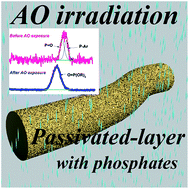Atomic oxygen resistance of polyimide fibers with phosphorus-containing side chains†
Abstract
A series of polyimide (PI) fibers were spun and exposed to atomic oxygen (AO). The PI fibers contained phosphorus in the macromolecular side chain, which was derived from DATPPO diamine. An AO exposure experiment was conducted in a ground-based AO-effect simulation facility. The changes in the surface morphologies and compositions of PI fibers before and after AO erosion were investigated by field emission scanning electron microscopy and X-ray photoelectron spectrometry (XPS). After AO exposure, the phosphorus-containing PI fibers exhibited a denser surface morphology compared with that of the pure PI fibers. XPS results indicated that phosphate species formed on the surfaces of phosphorus-containing PI fibers after AO exposure protected against further erosion. After AO erosion, the mass loss of phosphorus-containing PI fibers was lower than that of pure PI fibers. Moreover, at an AO fluence of 5.0 × 1020 atoms per cm2, the retention of tensile strength and Young's modulus of phosphorus-containing PI fibers were 64.87% and 66.04%, respectively, which were higher than those of pure PI fibers. The results of the current study are crucial for understanding the relationship between polymer structure and AO-resistant properties of PI fibers to develop new materials with low-earth orbit applications.



 Please wait while we load your content...
Please wait while we load your content...